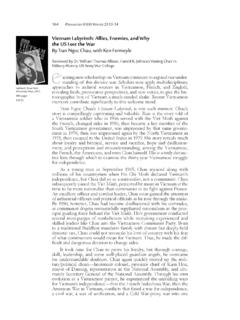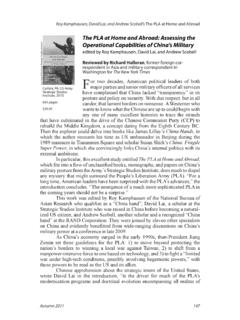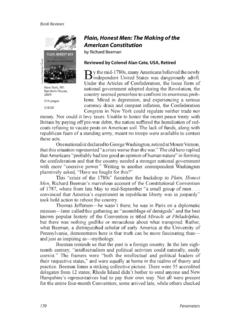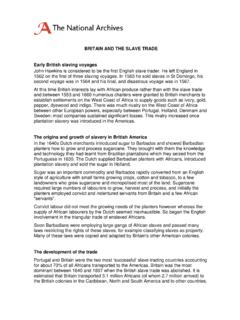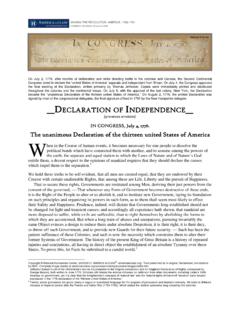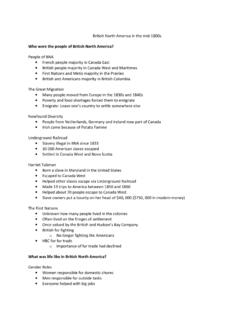Transcription of strAteGic leAdership iN W The Men Who Lost …
1 156 Parameters 43(4) Winter 2013-14. strAteGic leAdership in Wartime The Men Who Lost America: british leAdership , the American Revolution, and the Fate of the Empire By Andrew Jackson O'Shaughnessy Reviewed by Dr. James D. Scudieri, Department of Military Strategy, Plans, and Operations, US Army War College New Haven, CT: Yale T his work provides a welcome reappraisal of the british loss of their American colonies, , the American Revolution during 1775-83, in the context of british global strAteGic decisionmaking. The subject is University Press, 2013 not new. Author Andrew Jackson O'Shaughnessy credits Piers Mackesy, 466 pages The War for America, 1775-1783 (1964, reprinted 1992), on the first page $ of the Acknowledgment, highlighting Mackesy's belief that the war was winnable but was lost to poor generalship, among other things.
2 O'Shaughnessy states clearly that American victory was not inevitable. It is a somewhat harder task to challenge the conventional wisdom that the british loss was due to incompetence and mediocre leAdership , . both political and military. The author packages the monograph in nine biographical chapters, examining ten british leaders at policy, strAteGic , and theater strAteGic /operational levels, in sequence: King George III;. Lord North as prime minister; the Howe brothers, Admiral Lord Richard and Lieutenant General Sir William; Major General John Burgoyne; Lord George Germain, Secretary of State for the Colonies, a third Secretary of State created in 1768; Lieutenant General Sir Henry Clinton; Major General Charles, 1st Marquis Cornwallis; Admiral Sir George Rodney.
3 And John Montague, Earl of Sandwich, as First Lord of the Admiralty. The work features senior leaders wrestling with an unprecedented set of problems, in the author's words obstacles of such magnitude. He explains their decisionmaking in the overall context of the eighteenth century; the nature of the English state, extant political institutions, and their processes; global strategy; and ultimately the nature of the military element of power, land and naval. For example, despite the previously showcased ministry of Sir Robert Walpole in british history, O'Shaughnessy underlines the as-yet evolutionary nature of English gov- ernment at the time, especially the gradual development of true cabinet government with collective ministerial responsibility. His interpretation is not without controversy, at least insofar as extant practice to ensure political survival resulted in conduct for collective shielding.
4 He believes the most fundamental miscalculation of these senior leaders was the belief that Loyalists constituted a majority of the popula- tion in America. Moreover, these same leaders did not understand the changes that took place in the war's nature. Its length, seeming without end, increased popular antipathy toward british military presence. Significantly, O'Shaughnessy cites the Declaration of Independence as a seminal document for genuine, revolutionary change: a radical republi- can creed which beckoned a better future. Furthermore, in current terms, he sees a serious imbalance in ends, ways, and means. He highlights the major aspects of the post-war draw- down after 1748, following the end of the War of Austrian Succession. Book Reviews: strAteGic leAdership in Wartime 157.
5 He concludes that both the Royal Navy and british Army were too small for the task at hand. The latter simply lacked the strength to conquer and occupy the American colonies, especially given the alacrity with which Patriot forces had taken control of established institutions, further underlining Loyalist weaknesses. Multiple demands upon military power exacerbated this imbalance. O'Shaughnessy repeatedly reminds readers to comprehend Britain's global responsibilities. War against the thirteen American colonies occurred with simultaneous concerns for Canada, the Caribbean, India, and Europe itself. These other theaters became ones of pressing urgency with French and others' active intervention in the war from 1778. The author's analysis of the daunting logistical challenges to wage global warfare during this period could stand as a case study in its own right.
6 He summarizes and synthesizes a considerable body of primary evidence and historical examinations. The reality that the british Army in America could not sustain itself in theater came as a shock, and drove major aspects of planning. The dissection of such political and military decisions also accounts for the human domain. His ten main characters are not distant eighteenth- century aristocrats. They are individuals with strengths and weaknesses, and families upon whom they depended and who mattered greatly in their lives. He also shows how personalities mattered in the daily work- ings of governmental business and English society at large, including an explanation of the nature and role of the media in eighteenth-century England. He reviews the vocal, politically astute opposition to the war in England.
7 Moreover, he hints at English leaders' ambivalence on how to fight this war, typified by the Howe brothers and the Peace Commission. Few today, on either side of the Atlantic, appreciate how such diffidence became official confusion. America was in revolt, but somehow the situation was not the same as previous experience dealing with Ireland and Scotland. Perhaps the best manifestation of this doubt concerns the british Army. It never obtained battle honors for any victories in the course of the American War against the colonists. O'Shaughnessy's book does mirror earlier works in several ways. Besides Mackesy (already cited), Jeremy Black, War for America: The Fight for Independence, 1775-1783 (1991) also asserted that American victory was not inevitable. In other words, there are cogent explanations why the Revolution could have failed, or conversely, the british could have won.
8 Yet O'Shaughnessy's core thesis is well beyond the question whether the war was winnable. Herein is the freshness of the work. O'Shaughnessy does not rest with the mere assertion the british could have won. Indeed, he concludes conditions generally were not favorable for british victory. However, he categorically denies the stereo- type of british political and military incompetence, in stark contrast to William Seymour and W. F. N. Watson, The Price of Folly: british Blunders in the War of American Independence (1995). Indeed, he asserts chronic perceptions of incompetence have clouded how close and how often the outcome was in doubt. Moreover, his methodology is of particular interest to this readership. His analysis of leaders at multiple levels, from the british king to senior commanders in the field, is a masterful case study in both vertical 158 Parameters 43(4) Winter 2013-14.
9 And horizontal integration. The author delivers an early pledge to shatter old shibboleths in both the United States and the United Kingdom, as well as to challenge cherished aspects of American, national mythology. The specialist will find a few, minor errors. Regardless, this work stands as a major contribution with its phenomenal balance of primary and secondary sources and depth of synthesis across a staggering wealth of historiography on the American Revolution from the perspective of the subjects. The Men Who Lost America is an important book. It dissects the senior- level sausage making of the british effort to reassert control over its wayward colonies. It provides a case study of especial resonance today. It showcases the misunderstanding inherent in stereotypical and simplistic explanations.
10 Moreover, it does so in terms of special relevance to the readership of Parameters. On the Precipice: Stalin, the Red Army leAdership and the Road to Stalingrad, 1931-1942. By Peter Mezhiritsky Reviewed by Dr. Stephen Blank, strAteGic Studies Institute, US Army War College, American Foreign Policy Council England: Helion &. Company, 2012. T here is a compelling need for a systematic study of the topic outlined in the title, especially as so much more has been learned about Stalin and the Red Army since the collapse of the Soviet Union. Unfortunately, 399 pages this is not the book to fill that gap. Indeed, it represents a regression in $ our efforts to understand Stalin, the Red Army, and the Soviet system as a whole. In the last twenty years as some archives have been opened and Russian historians have enjoyed greater (though not full) freedom to publish about hitherto closed topics, we have learned a great deal about Stalin, his system, and the Red Army.
